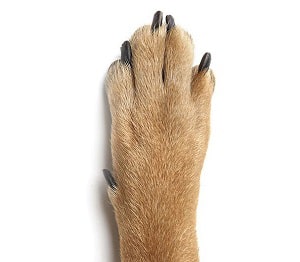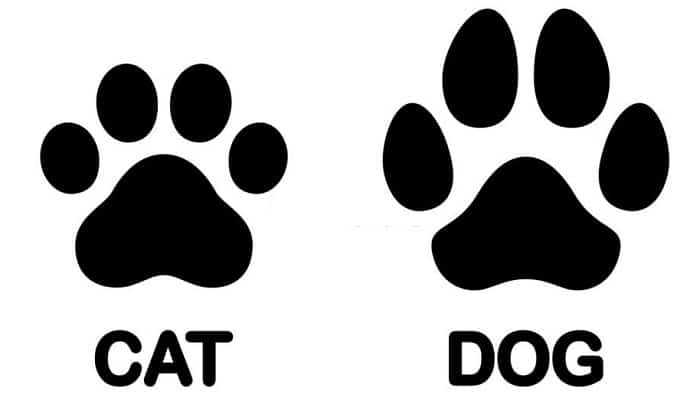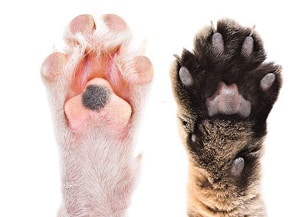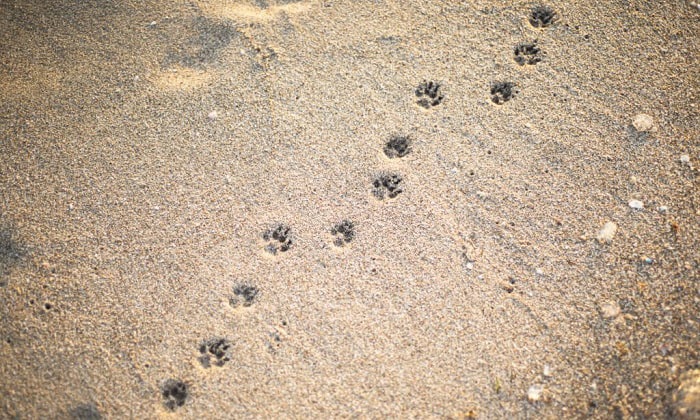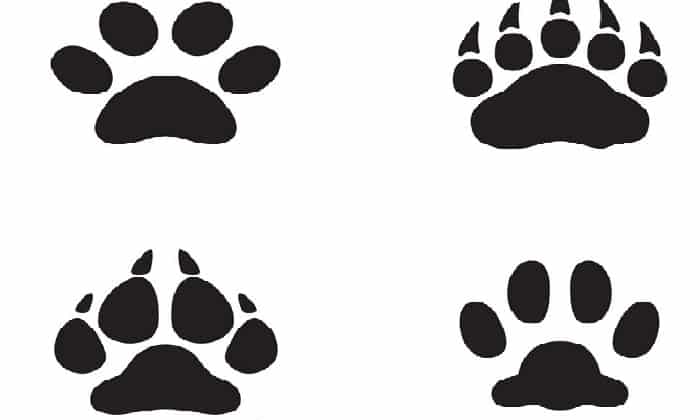People portray cats and dogs as archenemies. However, they also have uncanny similarities. One of these apparent similarities is that they have four paws.
But did you know their paws have differences, despite looking the same? This article will give you a comparison of a cat paw vs dog paw.
| Paw Characteristics | Cat | Dog |
| Claw | Retractable | Non-retractable |
| Shape | Circular | Oval |
| Plantar Pad Lobes | Two lobes at the front, three at the rear | One lobe in front, two at the rear |
| Paw Print Symmetry | Asymmetrical | Symmetrical |
| Paw Pads | Six pads, including the carpal and dewclaw | Five pads, including the dewclaw |
| Skin Texture | Soft | Shredded |
Table of Contents
Dog Paws Vs. Cat Paws: the Differences
Both the paws of cats play an essential role in their daily life. But the differences between these animals’ paws pretty much end there.
A closer inspection will reveal a few anatomical differences between the two.
1. Feline paws
A cat’s paw has tough skin on its pads. This skin protects its feet from injuries like scrapes when it walks on rough surfaces.
Despite the toughness of their skin, cat paws are sensitive. For this reason, a cat can tell the difference between hot and cold using its paws.
Apart from temperature, a cat’s paw can also detect sound, movement, and texture. Cats use their paws to identify what is safe and not.
Another fact about feline paws is that they have glands between the toes, which secrete a unique scent. Cats use these glands to mark their territory.
2. Canine paws
While cats have thick, tough skin on their paws, dog paws have a layer of fatty tissue. This tissue serves as a pad that protects a dog’s feet from cold surfaces.
Within the fatty tissues are arteries that absorb cold temperatures and bring the cold blood back to the dog’s body. The cold blood warms up there before it circulates back to the dog’s feet, allowing canines to withstand cold climates.
However, dog paws are heat sensitive. Your pet dog can quickly get burns and blisters when they walk on pavements in the summer.
Dogs also sweat on their paws, preventing them from drying out.
Identifying the Differences Between Cat and Dog Paws
Have you ever seen a paw print and wondered whether it is a cat’s or a dog’s paw? There are differences that will help you tell the two paws apart.
1. Claw
One of the major differences between a cat’s and a dog’s paws is their claws. Cats can retract their claws, so you will not find any claw marks when you see a real cat paw print.
Cat claws are not visible when they are in a relaxed state. But once a feline needs to climb up, catch prey, or protect itself, it extends its claws like a tool or weapon for self-defense.
On the other hand, dogs have non-retractable claws. They also walk on their toes, making their nails visible on their paw prints.
2. Overall shape and paw pads
The overall shape of a cat’s paw is circular. Its paws also have seven pads, including the pads of the five digital toes, the large heel pad, and the dew claw pad.
Now, pick up your dog and take a look at its paws. You will notice that its overall shape is oval.
If you ask, “how many paws do dogs have?” one can easily answer four. But do you know how many pads each paw has?
The answer is six. A dog’s paw has four digital pads, a plantar pad, and another pad on the carpal area.
3. Lobes on the plantar pads
If you look at the plantar pad or the large heel pad of a cat’s paw, you will notice two lobes on its front end and three at the back.
Meanwhile, a dog’s large heel pad has a single lobe in front and two at the back.
4. Dog print vs. Cat print symmetry
A cat’s paw print is asymmetrical. Meaning if you try drawing a straight line in the middle of a feline’s paw print, the left and right sides do not look the same.
The reason for this asymmetry is that the plantar pads of a cat are not exactly in the middle of its digital pads.
Now if you compare cat vs. dog tracks’ symmetry using a straight line, you will find out that a dog’s paw print is symmetrical.
5. Skin texture
If your feline friend allows you to touch its paws, you will instantly notice that they feel soft. They contain fat, a cushion that protects your cat’s feet when they jump from high places.
The texture is another paw characteristic that cats’ and dogs’ paws share, as both contain fat. If your dog’s paw pads look shredded, it is best to have it checked by a bet, as there may be an underlying medical condition.
Tips to Identify Cat or Dog Tracks
The best way to differentiate cat vs. dog paw prints is to check for nail marks. As mentioned, dogs cannot retract their claws.
So, if you find nail marks on paw prints, they are definitely a dog’s tracks.
You can also differentiate the two animals’ prints by noting what cat paws look like. If the print looks circular, it is a cat’s paw print.
You can also look at the number of lobes in the plantar pad print. A dog track should have a single front lobe on the plantar pad, while a cat should have two.
Tips to Know Domestic Dogs or Cat or Wild
1. Domesticated cats vs. Wild cats
Telling domestic and wild cat paw prints apart is relatively easy. If you find different cat paws around your home, you can tell if it is domestic or wild by looking at the size.
Small cat paws indicate a domestic cat’, while larger prints belong to a wild cat. For instance, a bobcat has paws that usually measure 2 to 2.5 inches, while a house cat’s paw typically measures 1 inch wide.
As wild cats are larger than domesticated cats, their tracks are also further apart than a house cat’s paw prints.
2. Domesticated dog vs. Wild dog
House dogs and wild dogs come in all sizes. So, you cannot differentiate their paw prints by comparing the size.
Instead, look at the claw marks in the paw prints. Wild dogs usually have sharper and more pointy nails than domesticated ones.
Domesticated dogs also tend to be more energetic than wild ones. Since wild dogs always need to stay alert and undetected by predators, they walk quietly, making their tracks clean.
Meanwhile, house dogs are playful, so their tracks are messy.
Frequently Asked Questions
Are cat paws dirtier than dog paws?
Due to their habit, you might notice that cat paws often look cleaner than dog paws. However, you still have to pay attention to their hygiene to avoid them licking hazardous bacteria and germs.
Why are cat paws softer than dog paws?
Cat paws feel soft due to the fat as the layer of cushion in there. Due to this cushion, cat ‘s feet are protected when it jumps around.
Conclusion
Differentiating a cat’s paw print from a dog’s track may not seem much, but it is an important skill. This fact is especially true for people living in areas where wild animals are present.
By being able to identify a house cat and dog’s paw print from the wild ones, you can avoid potential dangers like an animal attack when you go out of your house.
That said, we hope that this post is helpful in differentiating a cat paw vs. dog paw.
Read more: What is the difference between cat fleas vs dog fleas?

I am Amy Sawy, a Doctor of Veterinary Medicine (DVM) graduate from the University of Kansas. y husband, Dr. Plummer, and I own a veterinary clinic in Phillipsburg, Kansas. In addition to my professional background, I am a devoted pet owner myself, with a household that includes dogs, rodents, and most notably, cats – a total of five felines in my home.
In 2020, I joined an organization as a professional writer, leveraging my experience and collaborating with my team to deliver the most valuable information for your cat’s care.





